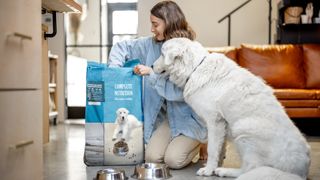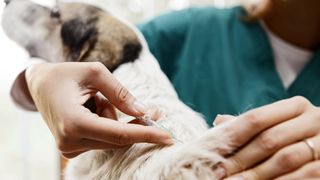32 simple ways to save money as a dog owner
Owning a dog is a long-term financial responsibility, but there are ways of paring down costs without skimping on health or welfare

There’s a saying in the equestrian world that the way to make a small fortune in horses is to start with a big one. While expenditure on our dogs is nowhere near the scale of horse ownership, it’s still a significant portion of our your monthly outgoings.
UK rehoming center Battersea estimates an annual expenditure of around $2,500 (£2,000) per dog, and as most dogs live for around 12 years, you can do the math.
However, there are ways to keep costs down, without compromising the health and welfare of your beloved pet. By eliminating surplus expenditure, you can streamline your budget to the essentials – and your dog won’t miss a thing.
32 simple ways to save money as a dog owner
1. Buy second-hand

Treating our pets to the best might be high on our list of priorities, but there are many products you can buy second-hand or even free. Browse online at sites like Facebook Marketplace, eBay and other selling sites – your dog won’t mind at all that it isn’t “brand new with tags”. If you have friends whose puppy has grown up, they are often happy to pass on doggy items their pup no longer uses – or fits into.
Cosy blankets are often a fraction of their original price in thrift shops, while items such as food storage boxes need not be bought new.
2. Make your own treats

Tasty titbits are handy for training, but store-bought treats tend to be pricey – and run out quickly. You can make your own homemade dog treats – out of ingredients such as pumpkin and peanut butter – which can be much more economically friendly than buying packets. The bonus is that you’ll know exactly what goes into them, so you can ensure the best ingredients for your dog.
3. Bulk-buy food

Much as it feels expensive to buy a large bag of dog food when finances are tight, it nearly always works out cheaper to buy in bulk. Just do some calculations to make sure that your dog will get through the food before it reaches its best-before date.
4. Home grooming

Does your dog need regular professional grooming at a parlour? Some dogs have abundant, luxurious coats that need tending with frequent trips to the salon. However, you can learn how to groom a dog including how to wash, brush and even clip your dog at home. Buying a set of clippers will quickly pay off in salon savings.
5. Shop around for medication

If your dog needs a regular medication, even on prescription from your vet, you may be able to save significantly by shopping around. You will still need your prescription, but you can often find a deal for the medicine itself online rather than buying direct from the vet. Of course, always use a reputable supplier.
6. Don’t delay on parasite control

It’s a false economy to think you can save your pennies by not deworming your dog, or stretching the periods between deworming. If your dog contracts one of the potentially fatal worms such as heart or lung, you will be paying thousands in vet fees to try to cure him.
Flea infestations aren’t cheap either, as you are likely to have to get professional pest control to exterminate them from your home. Be sure to check out our guide to the best flea treatment.
7. Make your own toys

Dog toys are often fiendishly expensive. But there are so many bits and bobs around the house that you can turn into toys – they just might not be as brightly coloured or shiny. For example, pierce a hole in an old tennis ball and attach it to some rope; or cut a slit in the ball and fill it with tasty titbits. Or plait some strips of material from old T-shirts into a tug-or-war toy.
Just remember to supervise your dog and to avoid any choking hazards.
8. Make your own puzzle games

Puzzles are great for dogs as they provide mental stimulation, which is particularly useful if they are busy, destructive or can’t go outside for exercise. You can do something really simple like hide-and-seek around the kitchen, or hide kibble under tennis balls in a muffin tin and watch him work out how to nose the balls out or pick them up with his teeth to reveal the treats.
9. Fix rather than throw

If your dog has ripped a hole in his bedding, blankets or coats, have a go at fixing it yourself rather than dropping it in the garbage. Even if you’re not naturally handy with a needle, there are mending-tapes and strips you can buy that are a fraction of the cost of a whole new bed.
10. Find a solution for dog-sitters

Paying a professional to look after your dog while you are on vacation, even for short periods, is a big extra on top of the annual canine outgoings.
Try to find venues where you can take your dog with you, and if it's not possible, how about asking a friend or family member to look after your dog for a spell. Ideally you can offer to return the favour when they go away, and then everyone’s a winner.
Another possibility is finding people who would like to stay in your home, in exchange for looking after your pet. There are various websites which arrange this, with secure references.
11. Dog-walking

If you employ a dog-walker to exercise your dog during the daytime while you are at work and you live nearby, ask your boss if they would permit you to return to take your dog out at lunchtimes – with the bonus that you get fresh air and a break from your desk.
If this isn’t feasible, how about setting up a group of friends who can take it in turns to walk each other’s dogs, say, once a week. Everyone benefits – including the happy pooches.
12. Share and share alike

Tap into the local canine community – or a bunch of dog-owning friends – to find out if you can borrow rather than buy high-cost items. Sharing things that are used only rarely, such as travel crates or a doggy playpen, saves on purchases which may only be used once or briefly.
13. Stay up to date with vaccinations

Prevention is always better than cure, especially when it comes to life-threatening diseases. The cost of treating the likes of parvovirus, leptospirosis, distemper and suchlike is far higher than vaccinating to ensure your dog doesn’t catch them. And who wants a very sick pup?
14. Keep your dog fit

Like humans, an overweight dog is much more likely to suffer from heart disease and other illnesses than a lean one. Use exercise as a preventative measure so that you don’t have to fork out for treating chronic illness further down the line.
15. Insurance

It’s tempting when you are on a tight budget to skimp on insurance. But this is a risky strategy. Dogs are accident-prone and you never know when illness might strike. The worst thing is to feel you are unable to pay for the treatment your dog deserves, and to have to make difficult decisions about their future. Veterinary surgery and care are so expensive, you’re better off to have an insurance policy that covers you, especially for unexpected out-of-hours emergencies that will really set you back financially.
16. Clip nails at home

Most dogs need their nails clipped regularly, unless they spend a lot of time exercising on rocky paths or roads. Rather than pay a vet or professional groomer to do this five-minute job, learn how to clip a dog’s nails using either specific canine nail clippers or a grinder.
17. Avoid unnecessary clothing

Many dog owners spend more on their dog’s wardrobe than their own. Before you buy him the latest fashionable coat or Christmas sweater, ask yourself whether he really needs another item in his wardrobe?
Dogs are blessed with wonderful natural coats, so they should not need to wear artificial coats indoors. Even outside, most dogs can cope well with inclement weather. The only additional coats they need are to keep them warm (if they are old, frail or their breed is not suited to bad weather) or for visibility in darkness or bad light.
18. Dog-proof your home

A common reason why dogs require emergency vet care is because they have ingested something poisonous, such as chocolate, cleaning products, rat poison, or even certain toxic plants.
Keep any toxic products well out of a dog’s reach.
19. First aid

Before you rush to the vet, assess whether the dog has something you can fix yourself. For example, ticks can be removed at home, minor cuts can often be cleaned with a simple saline solution.
Of course, if you have any concerns, do seek veterinary advice, but you’ll save yourself a good deal if you can sort out minor issues yourself.
You can also often video-call your vet for a lower fee than an in-person consultation if you want advice before deciding on a visit.
20. Be sparing with treats

Store-bought treats are expensive and not always made with healthy ingredients. Given that over 50% of dogs in the US are overweight or obese, arguably we should be feeding our pooches fewer treats. Slimmer, healthier dog, less money spent on treats, savings everywhere.
21. Shop around for insurance deals

Just like car insurance, it pays to shop around to get the best deal for canine cover. Rather than just rolling on year after year with the same company, check out whether their premiums match up well against other companies for the same cover. Often, if you find cheaper elsewhere, your existing provider may be able to cut you a deal.
There is sometimes a gift offered if you start with a new company, such as a month’s free cover, or a voucher if you recommend a friend. Every little helps.
22. Join a health plan

Many vets offer a healthcare plan which provides great value for money on essential care. A monthly fee will cover various regular treatments such as parasite control, vaccinations and health check-ups, as well as offers on dentistry, diets and medication.
Ask your vet and calculate whether they could offer you a saving on your annual budget.
23. Veterinary check-ups

Visiting your vet with a healthy dog can often feel like an unnecessary expense. However, with the mantra of prevention being better than cure, keeping on top of any potential issues will save you money in the long run rather than having to pay for more expensive vetcare when a treatable problem has deteriorated.
Most vets recommend either biannual or annual check-ups.
24. Brush your dog’s teeth

The majority of dogs suffer from periodontal disease – an infection of the tissues around their teeth – and bad breath during their lives. It can be expensive to treat, but if you keep on top of your dog’s dental hygiene from the puppy stage, you can keep these issues at bay. When you master how to brush a dog's teeth you can stop plaque forming and keep their breath fresh with daily brushing.
25. Portion control

Whether you have a greedy dog or a fussy one, measure out his food accurately. According to the Association for Pet Obesity Prevention, 59% of dogs are overweight or obese, which in basically means that they are eating more calories than they are expending, and therefore you can cut down on your food bill.
And if you have a dog that doesn’t eat all their food, you are likely to throw a lot away. If you have a picky dog that finds it hard to keep the weight on, it is better to feed smaller meals more frequently to tempt them – rather than throwing away good (and expensive) food.
26. Food banks

If you are really struggling to make ends meet, a food bank may be able to provide. There are food banks in various states in the USA and Canada, and many of the pet welfare organisations in the UK cater for dogs. By providing for our pets, they’re helping humans too, keeping their beloved pet in its rightful home, and also ensuring the human doesn’t go hungry feeding their dog instead of themselves. Some of these food banks will also offer neutering services and vaccinations.
27. Adopt, don’t buy

You can save yourselves thousands in the first place if you adopt a dog from a shelter rather than shelling out for a pedigree pooch. There is usually an adoption fee, but it is likely to be in the low hundreds rather than well into four figures.
Plus, you’re giving an unwanted dog a fresh start.
28. Discern the quality of food

While you must never skimp on the quality of your dog’s food, just because something is expensive does not mean it is automatically better than cheaper food. Research the ingredients: fillers, meat meal and processing, as well as anything artificial, is usually cheaper but less healthy for your dog. However, your dog doesn’t need to dine on wild bison and acai berries; ethically sourced chicken is a much cheaper protein option and it tends to be highly digestible.
29. Training fees

A well-trained dog is a delight to have around, but professional training fees are extremely high. With a little patience and plenty of research, you can save a lot of money by doing the training yourself. It’s also better in the long run, as you will build a great bond with your pup as he’ll always look to you for guidance. There are great free sources on YouTube and blogs with reputable trainers, and you can scour books (second-hand) with trainers whose methods you like.
If you really value personal time with a physical trainer, then group sessions are the way forward if you want to cut costs. It’s much cheaper than private sessions and your dog will be socialised at the same time.
30. Recycle your old furniture

You’d be surprised how many unwanted bits of your own furniture you can recycle into the large, high-cost items that your dog needs. For example sofa pads or old cot mattresses work really well in the crate or bed as a doggy mattress. An old bean bag that the children no longer want can be repurposed as a spare dog bed. Old blankets can go in the trunk of the car to stop dog hair accumulating, the list goes on!
31. Self-insure

While it’s undoubtedly a risky strategy, if you have a healthy dog of a breed that is not prone to illness and veterinary issues, you may choose to self-insure rather than pay for insurance cover. You should still make a regular deposit into an account specifically to pay for veterinary bills, but with a bit of luck, you’ll be in the black at the end of it. The more financially savvy will find a savings account that accrues a decent amount of interest, too.
32. Loyalty cards

Certain pet stores have loyalty cards to reward regular shoppers, and personalise their offers to their customers. Make the most of these and any store offers they have on from time to time.
PetsRadar Newsletter
Get the best advice, tips and top tech for your beloved Pets

Martha is an experienced journalist working in both print and digital media. She specializes in the canine, equine and rural sphere where she has covered a wide range of topics from cloning animals and the ingredients for a perfect yard dog, to helping owners find the best canine GPS trackers on the market. When she’s not busy writing about dogs and horses, she’ll be found either aboard a horse or looking after the menagerie of pets in her care.
